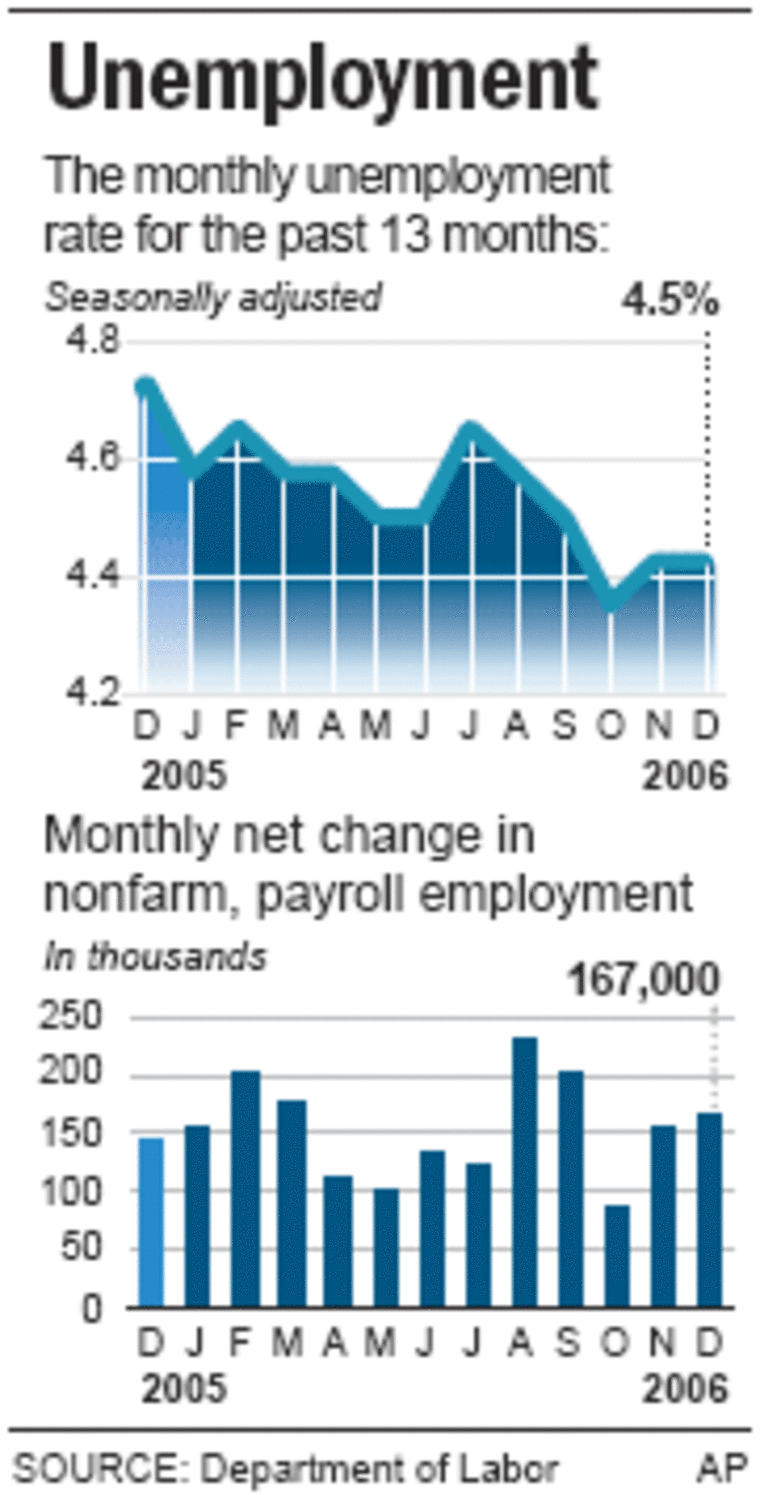Employers stepped up hiring last month, boosting payrolls by a brisk 167,000 and keeping the unemployment rate steady at a still historically low 4.5 percent. Workers’ wages grew briskly.
The latest snapshot of the nation’s employment climate, released Friday by the Labor Department, showed that the jobs market ended 2006 on a strong note and provided fresh evidence that the troubled housing and automotive sectors aren’t dragging down employment across the country.
The tally of new jobs added to the economy last month exceeded analysts’ forecasts for a gain of around 115,000 and was the best showing since September. Analysts were predicting the politically sensitive jobless rate would remain unchanged from November, which it did.
“This is a good report for the American worker,” said Ken Mayland, president of ClearView Economics.
For all of 2006, the nation’s unemployment rate dropped to a six-year low of 4.6 percent as the economy added 1.8 million jobs. In 2005, the unemployment rate averaged 5.1 percent.
With the economy losing momentum, though, many economists predict the jobless rate will climb this year and average around 4.9 percent.
In December, jobs gains in education and health care, business services, financial firms and leisure and hospitality swamped job losses in construction, manufacturing and retail. Jobs gains for both October and November turned out to be stronger than the government previously thought.
Many employers showed not only a greater appetite to hire in December but also more willingness to boost compensation to workers.

Workers, many of whom had seen their paychecks eaten by inflation, saw wages grow robustly last month. Average hourly earnings jumped to $17.04, a sizable 0.5 percent rise from the prior month. Analysts were forecasting a more modest, 0.3 percent increase.
Over the last 12 months, wages grew by a strong 4.2 percent. That matched the annual gain registered in November and was exceeded only by a 4.3 percent annual increase in November 2000.
Growth in wages should support consumer spending — a force that helps drive the economy. But a rapid and sustained advance — if not blunted by other economic forces — can stoke concerns about inflation.
Federal Reserve Chairman Ben Bernanke says the central bank will be on close watch for any signs that wage growth might be spurring an unwanted pickup in inflation.
The Federal Reserve, which has boosted rates 17 times since June 2004 to fend off inflation, has been on the sidelines since August. Analysts believe the Fed will keep its finger on the interest-rate pause button when it meets next on Jan. 30-31.
The latest employment snapshot comes as the new Democratic-controlled Congress, which convened Thursday, will now play a lead role in shaping policies for workers and businesses.
A top priority for Democrats is boosting the federal minimum wage from $5.15 an hour to $7.25 an hour. President Bush said he supports such a move as long as it is paired with business-friendly provisions, which would soften the sting to employers who would have to dole out more in labor costs.
The job hunt got shorter in December.
The average time that the 6.8 million unemployed people spent in their job searches was 15.9 weeks, down from 16.3 weeks in November.
On the payrolls front, education and health services added 43,000 jobs in December. Professional and business services added 50,000 slots. Leisure and hospitality expanded employment by 31,000 and financial firms added 9,000 new jobs.
Factories, however, cut 12,000 positions and construction companies eliminated 3,000 jobs - casualties of the souring housing market and the struggling auto industry. Retailers shed just over 9,000 slots.
Employment gains were stronger in both October and November. Employers added 154,000 new positions in November, versus the 132,000 reported last month. Payrolls grew by 86,000 in October, up from a previous estimate of a 79,000 gain.
The strong showing on jobs comes even as the economy lost steam throughout last year.
Economic growth slowed to a pace of 2 percent in the late summer — the most recent period available — and is expected to remain sluggish for a while as the economy works its way through fallout from the housing slump and the lingering impact of two years of rising interest rates.
Even with the expectations for slow growth ahead, most analysts don’t believe the economy will slide into recession, but they do predict that the unemployment rate will climb.